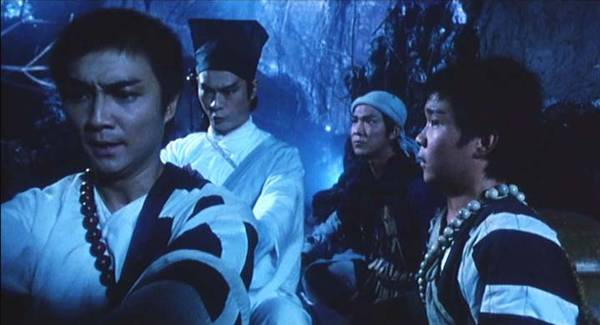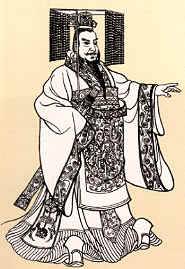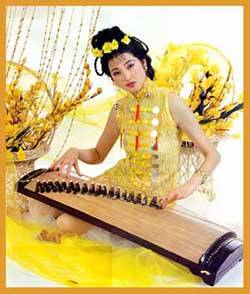 |
Qigong |
 |
 |
This term can be translated by ‘work on energy’. Qi meaning energy and gong: to exercise, to train. According to Dr Yang Jwing-Ming, all activities aiming at regulating the circulation of qi in the body can be qualified as qigong. Qigong is classified into two families (Wai dan et Nei dan) which are complementary; as for martial arts (external and internal).
Wai: external
Nei: internal
Dan: elixir (another term to designate Qi)
Qigong wai dan aims at storing qi at the body surface to then send it towards the latter’s depth. Acupuncture, the treatment by plants and some types of massages can be put under this designation. On the contrary, with qigong nei dan the storing of qi is done in the trunk so as to be then sent towards the limbs. It’s much harder to master and is often kept secret.
After this first distinction, 4 types of qigong appear:
The learned qigong to protect health.
The medical qigong to heal some diseases.
The martial qigong for a greater efficiency during fights.
The religious qigong to reach inspiration.
In Zu, warriors of the magic mountain by Tsui Hark, Ting Yin (Adam Cheng) uses a qigong by placing his hands on Xiao Ju’s back (Damian Lau) to exorcise evil and on Ti Ming-Chi’s (Yuen Biao) to transmit to him his techniques.

We will only talk about the martial qigong, the most represented in gong fu films (gong fu pian). Da Mo (Bodhidharma) can be said to be the founder of the martial qigong with the book he wrote at the Shaolin Temple : Yi jin jing (A classic on the transformation of muscles and sinews). Monks obtained a better physical condition but also a greater martial efficiency. The basic principle is to use one’s mind to guide the qi to the muscles so as to energize them and increase their power. With time and a deepening of the knowledge of acupuncture, techniques aiming at the vital points (Dian xue) and blood vessels (dian mai) developed. Qigong are generally good for health but some such as the ‘iron hand’ (tie sha zhang) can lead to important traumas on the hands and internal organs. See The One Armed Boxer by and with Jimmy Wang Yu.
Other qigong allow taking a lot of beating without suffering from injuries. It’s the case with the ‘iron shirt’ (tie bu shan) and the ‘blanket of the golden bell’ (Jin zhong zhao). In Warriors Two by and with Sammo Hung, one of the heroes’ enemies practises the iron shirt qigong. Zhao Qian-Hua (Casanova Wong) must simultaneously attack two vital points to defeat his opponent, the latter being able to protect only one vital point at a time.
Source : Tai chi chuan supérieur, Le style yang. Enseignement approfondi de la forme classique par le Dr Yang Jwing-Ming Ed : Budo
Links : http://www.librairieyoufeng.com/Livres.html
http://www.librairielephenix.fr/ |
 |
 |
top |
 |
 |
Qimendunjia |
 |
 |
Qimendunjia is the study of energies in the general sense. For the Chinese, the universe is composed of three major energies: the celestial, terrestrial and human energies. Those energy currents have a positive or negative influence on ourselves and on what surrounds us.

The ‘shushi’ or ‘qiren’, i.e. the master of ‘qimendunjia’ studies those different currents and advises his client on the attitude to adopt; in other words to follow the right current in search of beneficial things. The shushi can know the client’s past and future, his role is sometimes similar to the astrologist’s. Before, army leaders would consult the qiren; nowadays they are businessmen and politicians.
Feng Shui can be said to be related to qimendunjia.
The Chinese title of The Miracle Fighters by Yuen Woo Ping is « Qimendunjia ».
|
 |
 |
top |
 |
 |
Qin (dynasty) / Qin Shi Huangdi |
 |
 |

Qin Shi Huangdi ‘Founder Emperor of the Qin’ (221BC-206Bc): founder of the Qin dynasty.
King of Qin 247-221, Emperor of China 221-206 av. J-C
In 246BC, he ascends the throne under the name of Yin Zheng. Then, he declared himself as sole master of China and self-proclaimed himself as emperor. He took the title of Shi Huang Di. His whole reign will be based on terror and dictatorship. He resumed his predecessors’ work by annexing the kingdoms of Han (230), Zhao (228), Wei (225) and Qi (221) in about a decade. He unified the country and administered it with a central government. He standardised the weights and measures, car axles, the writing… on the advice of Lisi, his senior minister and a follower of the legist totalitarian philosophy. In 213BC, he organised autos-da-fe regarding works not in keeping with, according to him, the Qin philosophy. To protect the Empire from attacks of tribes of the North, the Xiongnu, he resumed the building of the Great Wall (changcheng), by calling on prisoners and conscripts. He thus fought the Xiongnu in Manchuria and Korea.
He was buried next to Xi’an with 6,000 terracotta statues of men and horses, all of them painted, which represented his army. Those famous warriors also known as Terracotta Warrior are present in the eponymous film by Tony Ching Siu Tung with Gong Li and Zhang Yimou. In Hero (Yingxiong) by Zhang Yimou, Qin Shi Huangdi is played by Chen Dao-Ming
Advised reading : Le disque de Jade by José Frèches
Source : Encarta. |
 |
 |
top |
 |
 |
Qin (music instrument) |
 |
 |
 A 7-string zither which can be between 90 and 130cm long and which dates back to the 5th century BC, which makes it one of the world’s oldest instruments. The Qin music is generally performed alone. The melodies played are similar to a meditation because of the deep tranquillity conveyed. A 7-string zither which can be between 90 and 130cm long and which dates back to the 5th century BC, which makes it one of the world’s oldest instruments. The Qin music is generally performed alone. The melodies played are similar to a meditation because of the deep tranquillity conveyed.
The old blind man in Hero by Zhang Yimou punctuates the inner fight of Jet Li and Donnie Yen (Zhen Zi-Dan) with this instrument. ‘Martial arts and music share the same principles. Their intensity allows to reach the supreme state’ as ‘Nameless’ remarks. In Blade Of Fury by Sammo Hung, Rosamund Kwan forgets her sadness by playing the Qin and in Kung Fu Cult Master by Wong Jing, Sharla Cheung Man uses it as a weapon.
Source : Encarta
|
 |
 |
top |
 |
 |
Qipao |
 |
 |
 The qipao (‘banner dress’) is also called Cheongsam (‘long dress’ in Cantonese). The Chinese traditional dress is characterized by a high collar and side slits, made of different fabrics and of various lengths, it is worn today on special occasions (weddings, New Year celebration, parties, etc.). The collar protects the throat but also emphasizes its delicacy. The slits have been conceived in a practical as well as aesthetic aim. The qipao (‘banner dress’) is also called Cheongsam (‘long dress’ in Cantonese). The Chinese traditional dress is characterized by a high collar and side slits, made of different fabrics and of various lengths, it is worn today on special occasions (weddings, New Year celebration, parties, etc.). The collar protects the throat but also emphasizes its delicacy. The slits have been conceived in a practical as well as aesthetic aim.
Now, qipao with slits of different lengths can be found (one or two slits on the side or at the front). The fabrics used are silk, silk brocade, satin, satin brocade or even velvet, almost all the colours are used. Some prints are added such as dragons, butterflies, some varieties of flowers and other typically Chinese icons symbolising prosperity, health. In the 17th century, in the north of China, a collar-less and tube-shaped dress developed, it was the ancestor of the qipao; its popularity reached the royal palace of the Qin dynasty and the castles of the Manchu nobility. The Manchu heads of state gathered some people, mainly Manchus, in ‘qi’ (banners) and named them ‘qiren’ (banners people). Later, this name of qiren applied to all Manchus. Manchurian women wore dresses made of one piece, which eventually resulted in qipao (banner dress). At that time, the dress was rather loose and its length would reach the instep. After the fall of the Qin, the qipao survived political changes. It still remains Chinese women’s traditional dress. |
 |
 |
top |
 |
|

|
